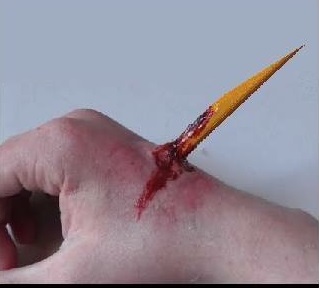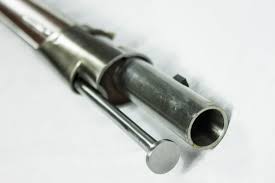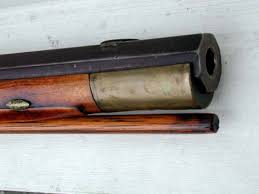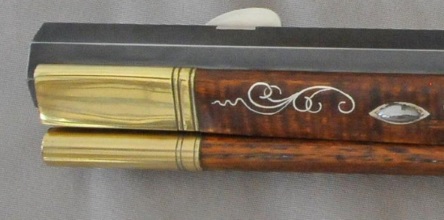It has been said that there are only two types of muzzleloaders; those who have broken a ramrod and those who are going to break one. Because wooden ramrods can and will break, safety should be the first concern. Forcing a tight load down the barrel is usually the moment when a weak or damaged wooden ramrod breaks. To avoid this,

grasp the ramrod no more than 6 inches above the muzzle when loading the gun.
The main reason wooden ramrods break is because of the type of wood used and the way they are made. A proper ramrod is constructed from a hard straight grained wood such as hickory. The grain in the wood should be straight over the entire length of the rod with no areas where the grain runs to the outside.

A run out of the grain creates a weak spot in the rod where it will eventually crack and break off. Ramrods supplied with most production guns and pre-assembled replacement rods are simply sawed and cut in the same manner as dowel rods. The odds of getting a rod made this way with no grain run out are very slim to none.
The best ramrods are made of split hickory, have no grain run out, are scraped to size, and seasoned by soaking them in kerosene over a period of time. Soaking the rod in kerosene or Old English Lemon Oil makes the rod more pliable and less likely to break. This can be easily accomplished with a section of PVC pluming pipe. Cut it long enough to contain one or more wooden rods, glue a cap on one end and a screw off cap on the other. If you want to stain the rod do that before soaking because it won’t take the stain very well afterwards.
When your rods have soaked for two or more weeks, cut them to length and install the brass tips. I do not like the end of my ramrod to extend past the muzzle when it is stored in the thimbles of the gun. I understand that the ramrod hole drilled in some gun stocks end even with or just slightly past the breach and this doesn’t leave much to get a hold on when the rod is fully inside the barrel. If that is an issue you can carry a brass, T shaped, threaded handle, or a wooden ball with a properly threaded screw in the shooting bag for those instances when it is necessary to pull a stuck ball or one loaded without powder. When the end of the ramrod sticks out past the muzzle it tends to snag on every bit of brush and tree limbs. That is not only a nuisance it can also break the rod. When attaching the brass tips I prefer to use epoxy and pins. Install the pins across the grain and they will not pull out so easily if you have to pull a stuck ball.
A ramrod is more than a simple stick used to load the rifle. With threaded metal tips installed on both ends the ramrod becomes a multipurpose tool used to load, clean, and maintain the gun. Attachments often carried in the shooting bag include a “T” shape extension handle, cleaning patch jag, patch worm, ball pulling screw, breach face scraper, and a bore brush. All these tools attach to the rod using a 10/32 or 8/32 threaded screw. This type of set up works very well in the field, when hunting or during rendezvous shoots. Those who shoot in organized competitions where the rifles are loaded at loading benches will use a metal range rod of brass or steel paired with a brass muzzle guide/protector and save the wooden ramrods for use in the field. This is a common practice today which serves very well.

This range rod is avaliable from Track of the Wolf
Is this the historically correct way to set up a ramrod? The answer would depend upon who, where, and when in history we are considering. Because wooden ramrods are easily lost and broken very few originals have survived. No doubt the ramrods found with original rifles are very old, but they are not likely the one originally supplied with the gun. When a wilderness hunter, trapper, or farm boy lost or broke a ramrod the most expedient way to replace it would be to cut a sapling and whittle it to fit the thimbles of the rifle. Lacking access to iron or brass tips, or the tools to make them, it is reasonable that a simple bare stick would suffice.

Military arms were equipped with metal ramrods and at least a few Hawken pistols were known to have attached metal loading rods. On the other hand rifles and smoothbores for civilian use would have had wooden ramrods. Whether those ramrods were always equipped with metal tips threaded for attachments or not can be difficult to determine. Descriptions of gun worms available during the rendezvous period of the fur trade are of a spiral shaped wire that would twist onto a bare stick. Flax fibers (tow) were then wound into the worm and used to wipe the rifle bore. This type of gun worm would work very well on a bare stick and lists of trade goods show these were abundant.

If one chooses to hang a bare stick in the thimbles of his flintlock because he feels it is more authentic who is to say he shouldn’t? However, I am unable to find enough documentation to say with any authority that original wooden ramrods were never equipped with threaded metal tips. Neither have I been able to distinguish the difference if any, between the ramrod and the wiping stick often referred to in descriptions of the Rocky Mountain fur trappers. Nevertheless I am certain that synthetic ramrods have no place at a historical reenactment and half stocked plains rifles should not have metal ramrods hanging under the barrel.
Discussing the issue of replacement ramrods over many campfires with experienced buck skinners, I’ve encountered a few old timers who proudly boast of having shot these muzzle loaders for fifty plus years and never broken a ramrod. Typically these fellows are shooting custom built rifles and the rod that came with it is a proper split hickory rod.
Those of us who use production built guns are not so fortunate. My first rifle was a CVA kit. There was no internet in those days and information on muzzle loaders was difficult to find. When that rod broke during a hunt, I cut and whittled a sapling to make do. Unable to find a source for a replacement rod I wound up searching through a lot of oak dowels at a home improvement store until I found one reasonably straight with no knots and little run out. None of the rods I made from oak dowels lasted long.
Eventually I found a fiberglass range rod at a gun shop and thought that would be the answer. It had a brass tip cleaning jag that screwed off to reveal a ball pulling screw. That rod never broke but I got fiberglass splinters in my hands every time I used it. Fortunately I didn’t use it long enough to damage the crown on my rifle. Soon after, the “unbreakable” ramrods appeared on the market. These things were advertised as being able to withstand bending them into a horse shoe without breaking. They are made of a dark brown synthetic material and not as heavy as a metal rod. It looked like a good rod for the little Frontier rifle I had for the kids to shoot. It broke during the first event.
It was about this time when I first started seeing brass rods in the thimbles of half stock rifles at rendezvous. It seemed a lot of folks were frustrated with the poor quality of the wooden ramrods available. And the problem isn’t limited to production guns. I own a semi-custom trade gun and the hickory rod supplied with it had so much grain run out that I never tried to use it.
In an ideal world we would be able to purchase well made, split hickory ramrods. But unless you have access to good hickory logs, the necessary wood working tools to make a ramrod, or a good friend who does, that world no longer exists. Thanks to the internet it isn’t as difficult to locate suppliers and products for muzzleloaders today. Premade wooden ramrods can be purchased to fit the more popular production guns but there is no guarantee these will be free of run out.
The best way I know to get a decent ramrod is to buy a half dozen or so full length hickory rods from one of the muzzleloader suppliers. Select one where any runout is near the ends and can be cut off while leaving the needed length to fit the gun. It isn’t necessary for the rod to be perfectly straight. A slight bend in the rod helps hold it snug in the thimbles. Any short pieces left can be used for pistols or to make short starters.
Some guns need a tapered ramrod. This is usually because the ramrod hole in the stock has to be small in order for the rod to pass lock bolts or allow the rod to be made long enough for the barrel length. It is easy to make a scraper from a worn out reciprocating saw blade by drilling a hole near the edge, cutting a “V” shaped notch from the edge to the hole, and filing a sharp, single bevel edge with a round file. Mount the scraper in a bench vise and you can easily pull the rod over it removing curls of wood until the desired dimensions are reached. There is no good reason for having a ramrod stuck in the thimbles because humidity caused the wood to swell. Simply scrape or sand it down to proper size.
When selecting brass tips for your rod be sure one is small enough to pass through the thimbles and reach the bottom of the ramrod hole in the stock. The tip on the other end doesn’t have to be the same size, my smoothbore guns have small tips on the bottom end and larger tips at the muzzle end which are closer in size to the bore diameter. Of course those rods are tapered and the wood is flush with the edge of the brass tips at both ends.
The book Recreating the American Long Rifle by Buchele and Shumway includes a chapter on ramrods. Shumway recommends that the brass tip on the rod be constructed to match the length of the brass nose cap. I cannot say if this is historically correct for original rifles, but I agree with Shumway that it is more appealing to the eye. The brass nose cap on my Lancaster rifle is two inches long and the rod supplied with the rifle had no metal tip on the muzzle end. When I made a new ramrod for this rifle the only brass tips to be found are an inch and a half long and it just didn’t look right. Not having access to a milling machine or a lathe, I was unable to make a suitable one and the cost of outsourcing a custom made tip seemed cost prohibitive. What I ended up doing was cutting a half inch off of another brass tip and installing that on the rod below the threaded tip. The brass tip now matches the length of the brass nose cap and is much more pleasing to the eyes. This may not seem like an important issue but this is a particularly beautiful rifle with relief carvings and extra fancy wood and the mismatched brass at the muzzle was a visual distraction.
 A beautiful ramrod tip matching the length and style of the nose cap.
A beautiful ramrod tip matching the length and style of the nose cap.
In summary, what most shooters I observe are doing is using a one piece metal range rod with a brass muzzle protector whenever possible and leaving the wooden ramrods in the thimbles for use in the field and historical events. Synthetic ramrods are simply inferior to the one piece range rod of brass or stainless steel and neither have any place at an historic event. Civilian guns should have wooden ramrods and Military guns should have metal rods according to their place in time and location.
I make my ramrods from the best hickory rods I can purchase from muzzle loading suppliers such as Track of the Wolf, or Dixie Gun Works. These are stained then soaked in Old English Lemon Oil before cutting to length and installing threaded brass tips. I typically make up two rods to fit each gun because it is only a matter of time before a wooden rod breaks and it usually happens in the middle of a match. Having a spare ramrod available at camp or in your vehicle can save a lot of frustration.
